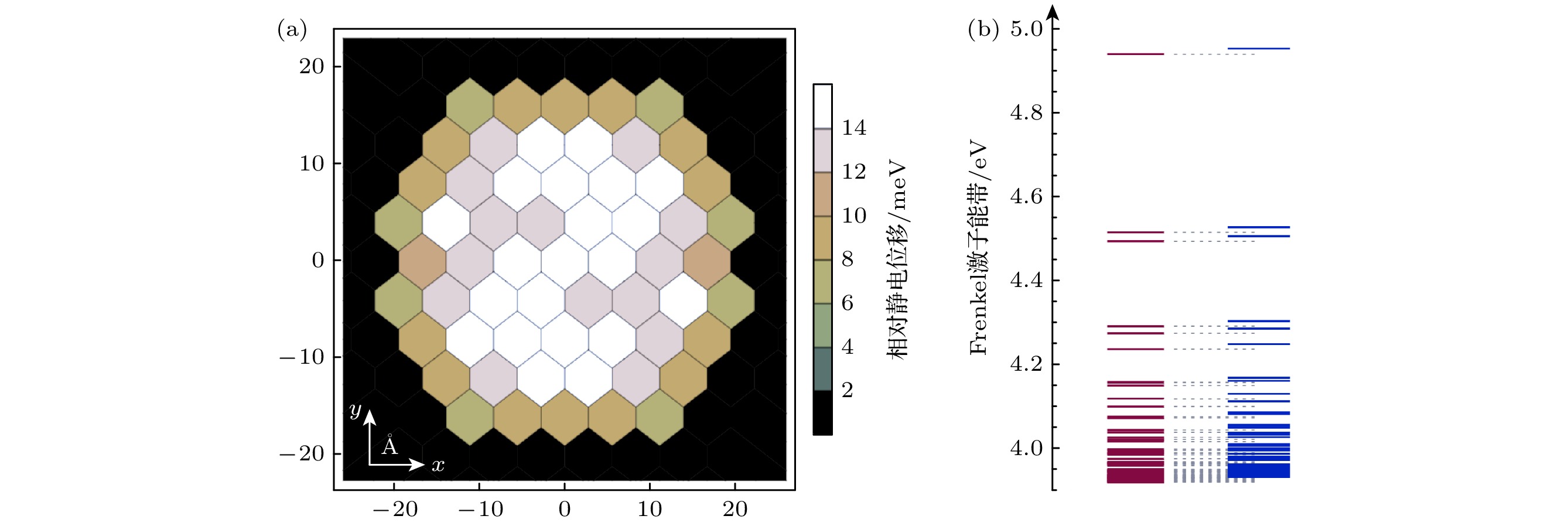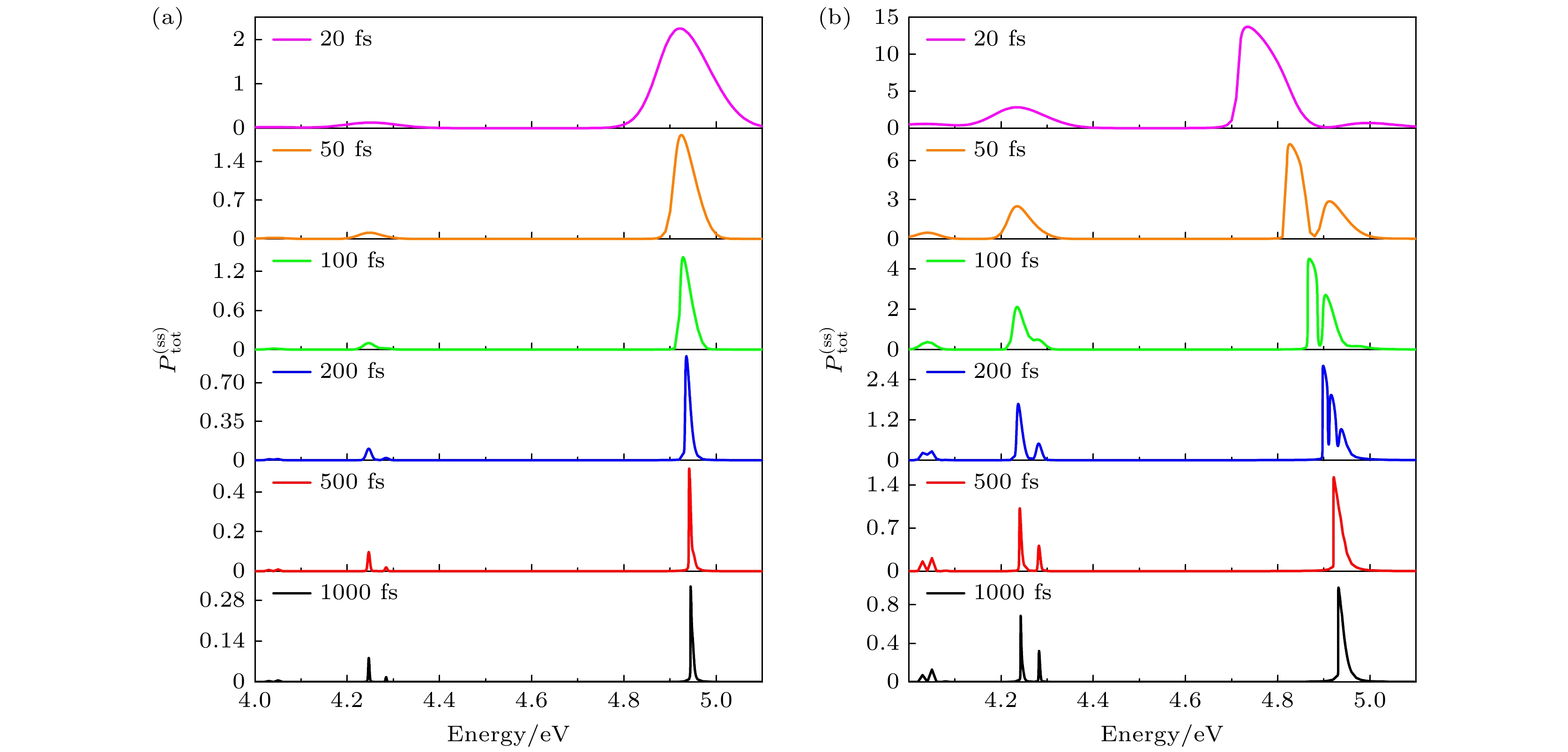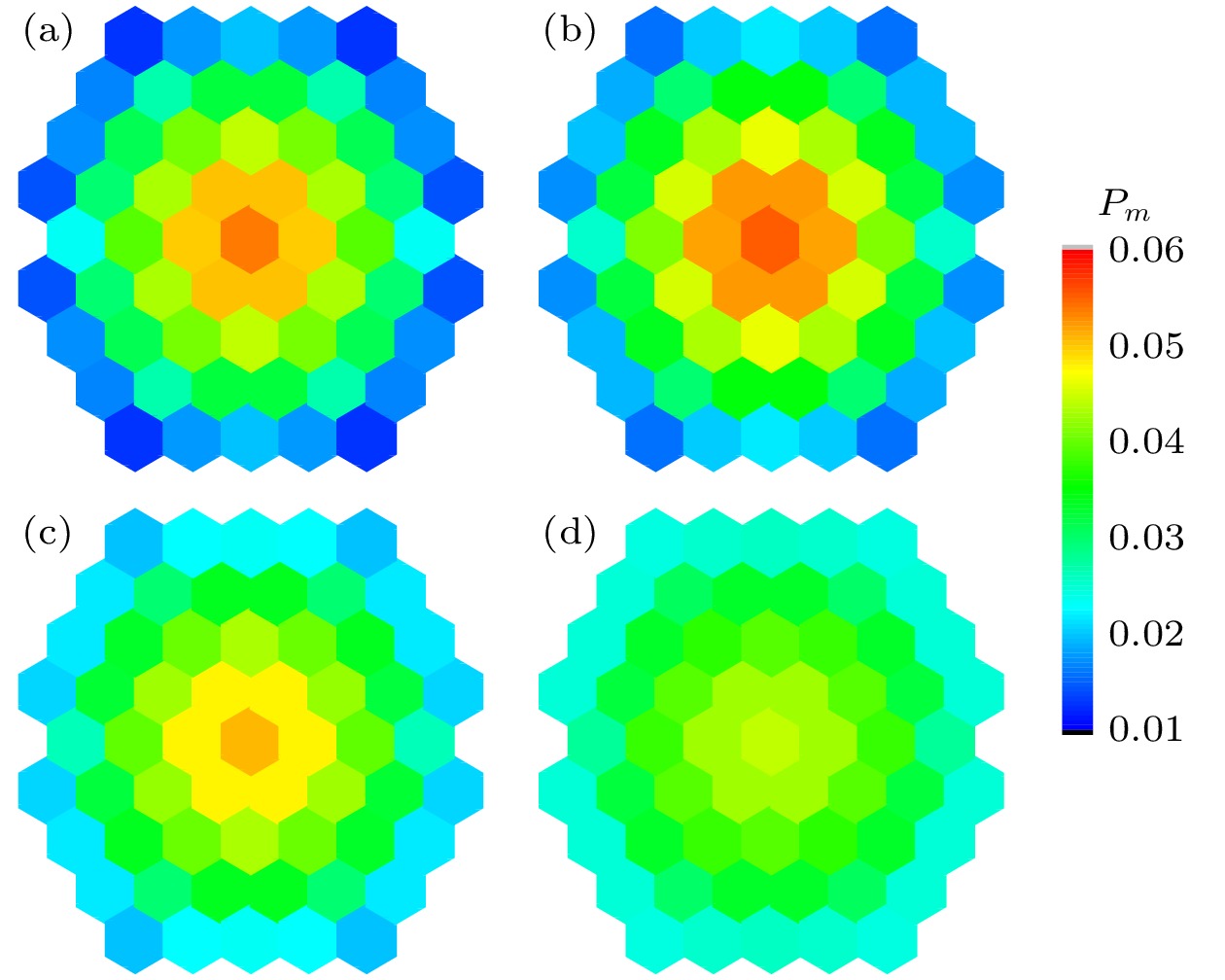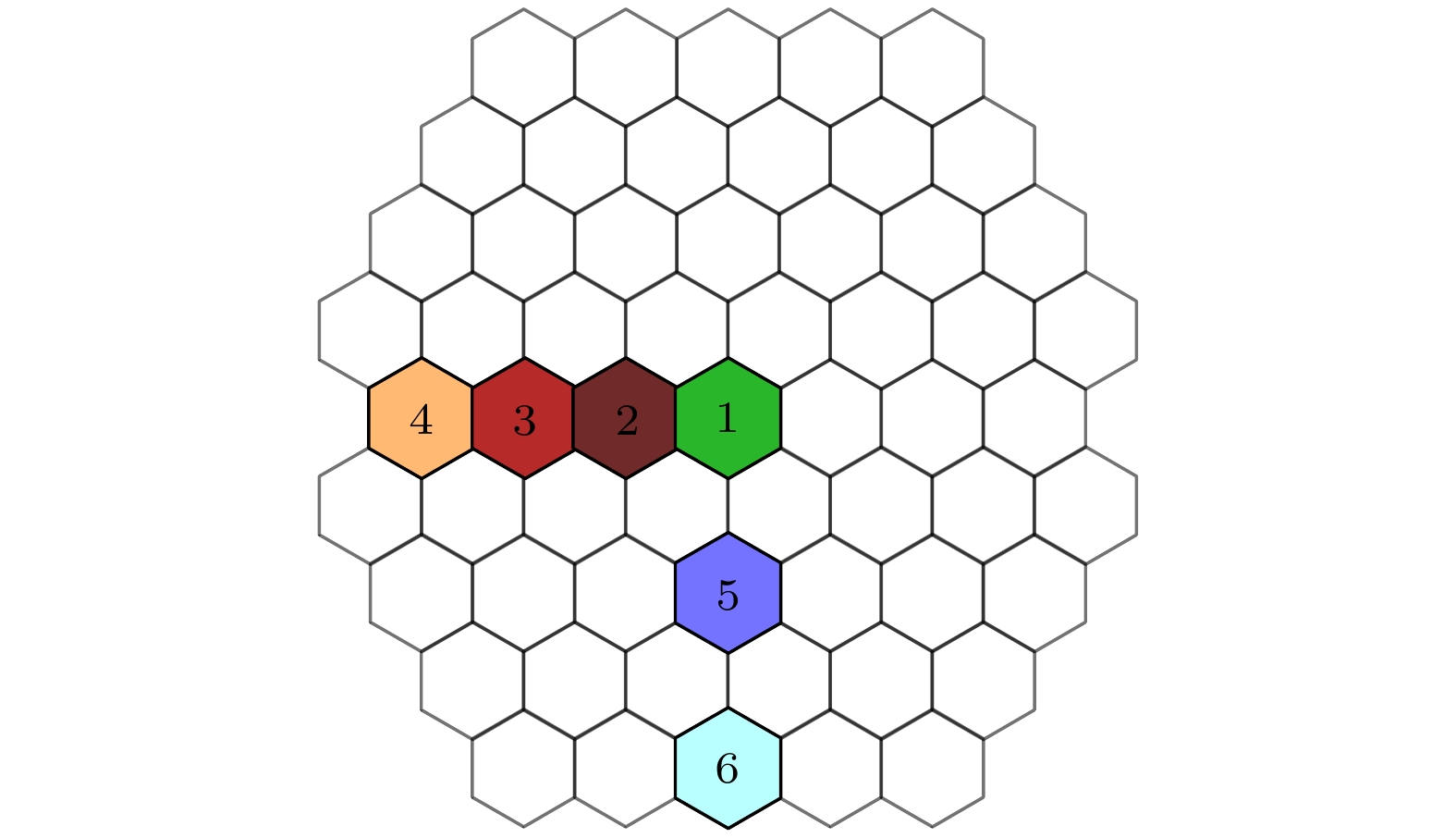-
激发能量转移是影响对六苯相关器件应用的重要因素之一, 研究对六苯团簇在不同外场激发作用下的激子动力学过程及激子相干效应, 这对于提高由对六苯及其相关衍生物所组成的分子器件的应用性能具有重要意义. 本文基于密度矩阵理论, 采用算符的数学平均值近似, 应用不同脉冲场激发盘状对六苯分子团簇, 对其激子动力学过程及激子相干行为进行了分析. 研究发现, 当处于强场短脉冲激发时, 团簇内产生多激子效应, 激子能级出现新的杂化态. 在短脉冲激发下, 在不同能量区域激发态分布不同, 但均表现出明显对称性. 由于H型团簇最高能级的激子态被优先激发, 发现随脉冲场增大, 激子相干增强, 当脉冲场较大时, 在脉冲激发过程中, 激子振荡协同性消失, 极短时间内大量分子产生激子相干, 出现瞬态离域现象.Excitation energy transfer is one of the most important factors affecting the applications of para-sexiphenyl devices. The study of exciton dynamics and exciton coherence effect of para-sexiphenyl clusters under external field excitation is important in order to improve the performance of molecular devices composed of para-sexiphenyl and its related derivatives. In this work, the two-dimensional disc-like para-sexiphenyl molecular cluster is used as the object of study. The molecular system is simplified into a two-level model based on its structural features and energy level distribution. Within the framework of density matrix theory, the exciton dynamics and exciton coherence behavior of disk-like para-hexaphene molecular clusters excited by different pulse fields are analyzed through using the mathematical mean value approximation of the operator. The results show that when long pulses are used to excite para-sexiphenyl clusters, the single exciton state characteristic appears and is insensitive to the change of excited external field strength. When the clusters are subjected to strong pulsed fields with short pulse widths, multiple excitons are excited simultaneously in the cluster, forming multiple exciton states, with the exciton energy levels shifting toward lower energy and new hybrid states appearing. In the optical response spectrum, there appear multiple resonance peaks. And as the pulse field is enhanced, the multi-exciton effect becomes apparent and the hybridization energy level increases. Under short pulse excitation, the excited states are distributed differently in different energy regions, but all of them show obvious symmetry. As the highest-energy exciton states of H-type clusters are preferentially excited, we analyze the exciton state population and the exciton coherence evolution with time in the high-energy exciton state. With the pulse field increases, Rabi oscillations appear and the exciton coherence effect increases. When the pulsed field reaches a certain field strength, the exciton oscillation cooperativity disappears in the first 100 fs, showing the non-local characteristic. The position of the wave trough of the exciton state population corresponds to the peak in the exciton coherence size. It indicates that when the pulse field is intense enough, a large number of molecules are in the exciton coherent state during the pulsed excitation, and transient out-of-domain phenomena occur.
[1] O’ Carroll D M, Petoukhoff C E, Kohl J, Yu B X, Carter C M, Goodman S 2013 Polym. Chem. 4 5181
 Google Scholar
Google Scholar
[2] Reineke S, Thomschke M, Lussem B, Leo K 2013 Rev. Mod. Phys. 85 1245
 Google Scholar
Google Scholar
[3] Zhang C X, Liu R G, Mak C H, Zou X L, Shen H H, Leu S Y, Ji L, Hsu H Y 2018 J. Photonics Energy 8 021001
 Google Scholar
Google Scholar
[4] Spano F C, Silva C 2014 Annu. Rev. Phys. Chem. 65 477
 Google Scholar
Google Scholar
[5] Brixner T, Hildner R, Kohler J, Lambert C, Wurthner F 2017 Adv. Energy Mater. 7 1700236
 Google Scholar
Google Scholar
[6] Tamai Y, Ohkita H, Benten H, Ito S 2015 J. Phys. Chem. Lett. 6 3417
 Google Scholar
Google Scholar
[7] Resel R 2003 Thin Solid Films 433 1
 Google Scholar
Google Scholar
[8] Zojer E, Koch N, Puschnig P, Meghdadi F, Niko A, Resel R, Ambrosch-Draxl C, Knupfer M, Fink J, Bredas J L, Leising G 2000 Phys. Rev. B 61 16538
 Google Scholar
Google Scholar
[9] Palczynski K, Heimel G, Heyda J, Dzubiella J 2014 Cryst. Growth Des. 14 3791
 Google Scholar
Google Scholar
[10] Choi A, Kwon Y N, Chung J W, Yun Y, Park J I, Lee Y U 2020 AIP Adv. 10 025127
 Google Scholar
Google Scholar
[11] Zhang Y, Wei X C, Zhang H, Chen X, Wang J 2018 Appl. Surf. Sci. 427 452
 Google Scholar
Google Scholar
[12] Li Y, Wang H, Zhang X H, Zhang Q, Wang X S, Cao D F, Shi Z S, Yan D H, Cui Z C 2016 RSC Adv. 6 5377
 Google Scholar
Google Scholar
[13] Katiyar S, Verma N, Jogi J 2022 Semicond. Sci. Technol. 37 025008
 Google Scholar
Google Scholar
[14] Yang X X, Feng X, Xin J H, Zhang P L, Wang H B, Yan D H 2018 J. Mater. Chem. C 6 8879
 Google Scholar
Google Scholar
[15] Usluer O, Demic S , Kus M, Ozel F, Sariciftci N S 2014 J. Lumines. 146 6
 Google Scholar
Google Scholar
[16] Simbrunner C, Hernandez-Sosa G, Baumgartner E, Hesser G, Roither J, Heiss W, Sitter H 2009 Appl. Phys. Lett. 94 073505
 Google Scholar
Google Scholar
[17] Jiang X X, Dai J G, Wang H B, Geng Y H, Yan D H 2007 Chem. Phys. Lett. 446 329
 Google Scholar
Google Scholar
[18] Winder C, Andreev A, Sitter H, Matt G, Sariciftci N S, Meissner D 2003 Synth. Met. 139 573
 Google Scholar
Google Scholar
[19] Qian C, Sun J, Kong L A, Gou G Y, Zhu M L, Yuan Y B, Huang H, Gao Y L, Yang J L 2017 Adv. Funct. Mater. 27 1604933
 Google Scholar
Google Scholar
[20] Simbrunner C 2013 Semicond. Sci. Technol. 28 053001
 Google Scholar
Google Scholar
[21] Wang L, Plehn T, May V 2020 Phys. Rev. B 102 075401
 Google Scholar
Google Scholar
[22] Lee J, Zhang Q, Park S, Choe A, Fan Z, Ko H 2016 ACS Appl. Mater. Interfaces 8 634
 Google Scholar
Google Scholar
[23] Li G C, Zhang Q, Maier S A, Lei D 2018 Nanophotonics 7 1865
 Google Scholar
Google Scholar
[24] Fernandes J D, Pazin W M, Aroca R F, Macedo W D J, Teixeira S R, Constantino C J L 2019 Spectroc. Acta A 211 221
 Google Scholar
Google Scholar
[25] Zhang Y, Meng Q S, Zhang L, Luo Y, Yu Y J, Yang B, Zhang Y, Esteban R, Aizpurua J, Luo Y, Yang J L, Dong Z C, Hou J G 2017 Nat. Commun. 8 15225
 Google Scholar
Google Scholar
[26] Han X B, Li F, He Z C, Liu Y H, Hu H T, Wang K, Lu P X 2022 Nanophotonics 11 603
 Google Scholar
Google Scholar
[27] Kramer S N, Brown J, Rice M, Peteanu L A 2021 J. Phys. Chem. Lett. 12 5919
 Google Scholar
Google Scholar
[28] Wang L, May V 2016 Phys. Rev. B 94 195413
 Google Scholar
Google Scholar
[29] Wang L, May V 2018 J. Phys. B 51 064002
 Google Scholar
Google Scholar
[30] Kasha M 1963 Radiat. Res. 20 55
 Google Scholar
Google Scholar
[31] Chakraborty S, Debnath P, Dey D, Bhattacharjee D, Hussain S A 2014 J. Photochem. Photobiol. A Chem. 293 57
 Google Scholar
Google Scholar
[32] Wu F P, Lu Y X, Mu X L E, Chen Z T, Liu S S, Zhou X F, Liu S F, Li Z B 2020 ACS Appl. Mater. Interfaces 12 32388
 Google Scholar
Google Scholar
[33] Zhao X J, Zhao H J, Wang S, Fan Z W, Ma Y, Yin Y M, Wang W, Xi R M, Meng M 2021 J. Am. Chem. Soc. 143 20828
 Google Scholar
Google Scholar
[34] Gomez-Sosa G, Beristain M F, Ortega A, Martínez-Viramontes J, Ogawa T, Fernández-Hernández R C, Tamayo-Rivera L, Reyes-Esqueda J A, Isoshima T, Hara M 2012 Opt. Mater. 34 856
 Google Scholar
Google Scholar
[35] Plehn T, Ziemann D, May V 2018 Phys. Chem. Chem. Phys. 20 26870
 Google Scholar
Google Scholar
[36] Plehn T, Ziemann D, May V 2019 J. Phys. Chem. C 122 27925
 Google Scholar
Google Scholar
[37] May V 2014 J. Chem. Phys. 140 054103
 Google Scholar
Google Scholar
[38] Hader K, Consani C, Brixner T, Engel V 2017 Phys. Chem. Chem. Phys. 19 31989
 Google Scholar
Google Scholar
[39] Zheng F L, Chen L P, Gao J B, Zhao Y 2021 Materials 14 3291
 Google Scholar
Google Scholar
[40] Fassioli F, Dinshaw R, Arpin P C, Scholes G D 2014 J. R. Soc. Interface 11 20130901
 Google Scholar
Google Scholar
-
图 2 二维对六苯团簇静电位移示意图 (a) 分子激发能的相对静电位移; (b) 分子激发能无(红色)及有(蓝色)静电位移时的Frenkel激子能带[21]
Fig. 2. Schematic diagram of the electrostatic displacement of two-dimensional 6P clusters: (a) Relative electrostatic shift of the molecular excitation energies; (b) Frenkel exciton energy band without (red) and with (blue) electrostatic shift of the molecular excitation energies[21].
图 3
$\kappa = 2 \times {10^{11}}{\text{ }}{{\text{s}}^{{{ - 1}}}}$ 时, 团簇内激发态布居$ P_{{\text{tot}}}^{\left( {{\text{ss}}} \right)} $ 随激光$\hbar {\omega _0}$ 、脉冲宽度${\tau _{\text{p}}}$ 变化 (a) 弱场${a_{\text{p}}}=5 \times {10^5}{\text{ ps}} {\cdot} {\rm{V{\cdot}m^{-1}}}$ ; (b) 强场${a_{\text{p}}}{\text{ = 2}}.5 \times {10^6}{\text{ ps}} {\cdot} {\rm{V{\cdot}m^{-1}}}$ Fig. 3. Excited-state populations
$ P_{{\text{tot}}}^{\left( {{\text{ss}}} \right)} $ in clusters vary with photon energy$\hbar {\omega _0}$ of the laser and pulse length${\tau _{\text{p}}}$ at$\kappa = 2 \;\times $ $ {10^{11}}{\text{ }}{{\text{s}}^{{{ - 1}}}}$ : (a) In weak fields${a_{\text{p}}}=5 \times {10^5}{\text{ ps}} {\cdot} {\rm{V{\cdot}m^{-1}}}$ ; (b) in strong fields$ a_{\text{p}}\text{ = 2}.5\times10^{6}{\text{ ps}} {\cdot} {\rm{V{\cdot}m^{-1}}} $ .图 4
$\kappa = 2 \times {10^{11}}{\text{ }}{{\text{s}}^{{{ - 1}}}}$ 时, 在长脉冲场 (a)${\tau _{\text{p}}}=1{\text{ ps}}$ 和短脉冲场(b)${\tau _{\text{p}}}=50{\text{ fs}}$ 下, 团簇内激发态布居$ P_{{\text{tot}}}^{\left( {{\text{ss}}} \right)} $ 随激光$\hbar {\omega _0}$ 、脉冲能量${a_{\text{p}}}$ 变化Fig. 4. Excited-state populations
$ P_{{\text{tot}}}^{\left( {{\text{ss}}} \right)} $ in clusters in long${\tau _{\text{p}}}=1{\text{ ps}}$ (a) and short${\tau _{\text{p}}}=50{\text{ fs}}$ (b) pulsed fields vary with photon energy$\hbar {\omega _0}$ of the laser and pulse energy${a_{\text{p}}}$ ,$\kappa = 2 \times {10^{11}}{\text{ }}{{\text{s}}^{{{ - 1}}}}$ .图 5
$\hbar {\omega _0} = 4.2483{\text{ eV}}$ ,$\kappa = 2 \times {10^{11}}{\text{ }}{{\text{s}}^{{{ - 1}}}}$ 时, 弱场短脉冲作用下(${a_{\text{p}}} = 5 \times {10^5}{\text{ ps}} {\cdot} {\rm{V{\cdot}m^{-1}}}$ ,${\tau _{\text{p}}} = 50~{\text{fs}}$ ), 4个不同时刻的分子激发态布居$ {P_m} $ (a)$t = 100{\text{ fs}}$ ; (b)$t = 200{\text{ fs}}$ ; (c)$t = 500{\text{ fs}}$ ; (d)$t = 1{\text{ ps}}$ Fig. 5. Molecular excited state populations
$ {P_m} $ at four different moments in the weak field with short pulses (${a_{\text{p}}} = $ $ 5 \times {10^5}{\text{ ps}} {\cdot} {\rm{V{\cdot}m^{-1}}}$ ,${\tau _{\text{p}}} = 50{\text{ fs}}$ ),$\hbar {\omega _0} = 4.2483{\text{ eV}}$ ,$\kappa = 2 \times $ $ {10^{11}}{\text{ }}{{\text{s}}^{{{ - 1}}}}$ : (a)$t = 100{\text{ fs}}$ ; (b)$t = 200{\text{ fs}}$ ; (c)$t = 500{\text{ fs}}$ ; (d)$t = 1{\text{ ps}}$ .图 6
$\hbar {\omega _0} = 4.9243{\text{ eV}}$ ,$\kappa = 2 \times {10^{11}}{\text{ }}{{\text{s}}^{{{ - 1}}}}$ 时, 弱场短脉冲作用下(${a_{\text{p}}} = 5 \times {10^5}{\text{ ps}} {\cdot} {\rm{V{\cdot}m^{-1}}}$ ,${\tau _{\text{p}}}{=}50{\text{ fs}}$ ), 4个不同时刻的分子激发态布居$ {P_m} $ (a)$t = 100{\text{ fs}}$ ; (b)$t = 200{\text{ fs}}$ ; (c)$t = 500{\text{ fs}}$ ; (d)$t = 1{\text{ ps}}$ Fig. 6. Molecular excited state populations
$ {P_m} $ at four different moments in the weak field with short pulses (${a_{\text{p}}} = $ $ 5 \times {10^5}{\text{ ps}} {\cdot} {\rm{V{\cdot}m^{-1}}}$ ,${\tau _{\text{p}}}{=}50{\text{ fs}}$ ),$\hbar {\omega _0} = 4.9243{\text{ eV}}$ ,$\kappa = 2 \times $ $ {10^{11}}{\text{ }}{{\text{s}}^{{{ - 1}}}}$ : (a)$t = 100{\text{ fs}}$ ; (b)$t = 200{\text{ fs}}$ ; (c)$t = 500{\text{ fs}}$ ; (d)$t = 1{\text{ ps}}$ .图 8
$\kappa = 2 \times {10^{11}}{\text{ }}{{\text{s}}^{{{ - 1}}}}$ 时, 短脉冲(${\tau _{\text{p}}} = 50{\text{ fs}}$ ,$\hbar {\omega _0} = 4.9243{\text{ eV}}$ )场下, 分子激发态布居$ {P_m} $ 随时间的演变 (a)${a_{\text{p}}} = 5 \times $ $ {10^5}{\text{ ps}} {\cdot} {\rm{V{\cdot}m^{-1}}}$ ; (b)$ {a_{\text{p}}} = {10^6}{\text{ ps}} {\cdot} {\rm{V{\cdot}m^{-1}}} $ ; (c)${a_{\text{p}}} = 2.5 \times {10^6}{\text{ ps}} {\cdot} {\rm{V{\cdot}m^{-1}}}$ ; (d)${a_{\text{p}}} = 5 \times {10^6}{\text{ ps}} {\cdot} {\rm{V{\cdot}m^{-1}}}$ Fig. 8. Molecular excited state populations
$ {P_m} $ in short pulsed fields (${\tau _{\text{p}}} = 50{\text{ fs}}$ ,$\hbar {\omega _0} = 4.9243{\text{ eV}}$ ) vary with time,$\kappa = 2 \times $ $ {10^{11}}{\text{ }}{{\text{s}}^{{{ - 1}}}}$ : (a)${a_{\text{p}}} = 5 \times {10^5}{\text{ ps}} {\cdot} {\rm{V{\cdot}m^{-1}}}$ ; (b)$ {a_{\text{p}}} = {10^6}{\text{ ps}} {\cdot} {\rm{V{\cdot}m^{-1}}}$ ; (c)${a_{\text{p}}} = 2.5 \times {10^6}{\text{ ps}} {\cdot} {\rm{V{\cdot}m^{-1}}}$ ; (d)${a_{\text{p}}} = 5 \times {10^6}{\text{ ps}} {\cdot} {\rm{V{\cdot}m^{-1}}}$ .图 9 在
$\kappa = 2 \times {10^{11}}{\text{ }}{{\text{s}}^{{{ - 1}}}}$ , 短脉冲(${\tau _{\text{p}}} = 50{\text{ fs}}$ ,$\hbar {\omega _0} = $ $ 4.9243{\text{ eV}}$ )场下, 激子相干尺寸$ {L_\rho } $ 随时间的演变Fig. 9. Exciton coherence size
$ {L_\rho } $ in short pulsed fields (${\tau _{\text{p}}} = $ $ 50{\text{ fs}}$ ,$\hbar {\omega _0} = 4.9243{\text{ eV}}$ ) vary with time at$\kappa = 2 \times $ $ {10^{11}}{\text{ }}{{\text{s}}^{{{ - 1}}}}$ .表 1 参数设置
Table 1. Parameters used.
名称/单位 数值 分子数${N_{{\text{mol}}}}$ 59 分子本征态能量$ {E_{{\text{mol}}}} $/eV 4.02 分子偶极矩$ {d_{{\text{mol}}}} $/D 12.4 分子间激发能量转移速率$\kappa $/(1011 s–1) 2 脉冲场频率${\omega _0}$ 随${E_0}/\hbar $变化 脉冲场强度${E_0}$/(V·m–1) 105—108 脉冲宽度${\tau _{\text{p}}}$/fs 20—1000 -
[1] O’ Carroll D M, Petoukhoff C E, Kohl J, Yu B X, Carter C M, Goodman S 2013 Polym. Chem. 4 5181
 Google Scholar
Google Scholar
[2] Reineke S, Thomschke M, Lussem B, Leo K 2013 Rev. Mod. Phys. 85 1245
 Google Scholar
Google Scholar
[3] Zhang C X, Liu R G, Mak C H, Zou X L, Shen H H, Leu S Y, Ji L, Hsu H Y 2018 J. Photonics Energy 8 021001
 Google Scholar
Google Scholar
[4] Spano F C, Silva C 2014 Annu. Rev. Phys. Chem. 65 477
 Google Scholar
Google Scholar
[5] Brixner T, Hildner R, Kohler J, Lambert C, Wurthner F 2017 Adv. Energy Mater. 7 1700236
 Google Scholar
Google Scholar
[6] Tamai Y, Ohkita H, Benten H, Ito S 2015 J. Phys. Chem. Lett. 6 3417
 Google Scholar
Google Scholar
[7] Resel R 2003 Thin Solid Films 433 1
 Google Scholar
Google Scholar
[8] Zojer E, Koch N, Puschnig P, Meghdadi F, Niko A, Resel R, Ambrosch-Draxl C, Knupfer M, Fink J, Bredas J L, Leising G 2000 Phys. Rev. B 61 16538
 Google Scholar
Google Scholar
[9] Palczynski K, Heimel G, Heyda J, Dzubiella J 2014 Cryst. Growth Des. 14 3791
 Google Scholar
Google Scholar
[10] Choi A, Kwon Y N, Chung J W, Yun Y, Park J I, Lee Y U 2020 AIP Adv. 10 025127
 Google Scholar
Google Scholar
[11] Zhang Y, Wei X C, Zhang H, Chen X, Wang J 2018 Appl. Surf. Sci. 427 452
 Google Scholar
Google Scholar
[12] Li Y, Wang H, Zhang X H, Zhang Q, Wang X S, Cao D F, Shi Z S, Yan D H, Cui Z C 2016 RSC Adv. 6 5377
 Google Scholar
Google Scholar
[13] Katiyar S, Verma N, Jogi J 2022 Semicond. Sci. Technol. 37 025008
 Google Scholar
Google Scholar
[14] Yang X X, Feng X, Xin J H, Zhang P L, Wang H B, Yan D H 2018 J. Mater. Chem. C 6 8879
 Google Scholar
Google Scholar
[15] Usluer O, Demic S , Kus M, Ozel F, Sariciftci N S 2014 J. Lumines. 146 6
 Google Scholar
Google Scholar
[16] Simbrunner C, Hernandez-Sosa G, Baumgartner E, Hesser G, Roither J, Heiss W, Sitter H 2009 Appl. Phys. Lett. 94 073505
 Google Scholar
Google Scholar
[17] Jiang X X, Dai J G, Wang H B, Geng Y H, Yan D H 2007 Chem. Phys. Lett. 446 329
 Google Scholar
Google Scholar
[18] Winder C, Andreev A, Sitter H, Matt G, Sariciftci N S, Meissner D 2003 Synth. Met. 139 573
 Google Scholar
Google Scholar
[19] Qian C, Sun J, Kong L A, Gou G Y, Zhu M L, Yuan Y B, Huang H, Gao Y L, Yang J L 2017 Adv. Funct. Mater. 27 1604933
 Google Scholar
Google Scholar
[20] Simbrunner C 2013 Semicond. Sci. Technol. 28 053001
 Google Scholar
Google Scholar
[21] Wang L, Plehn T, May V 2020 Phys. Rev. B 102 075401
 Google Scholar
Google Scholar
[22] Lee J, Zhang Q, Park S, Choe A, Fan Z, Ko H 2016 ACS Appl. Mater. Interfaces 8 634
 Google Scholar
Google Scholar
[23] Li G C, Zhang Q, Maier S A, Lei D 2018 Nanophotonics 7 1865
 Google Scholar
Google Scholar
[24] Fernandes J D, Pazin W M, Aroca R F, Macedo W D J, Teixeira S R, Constantino C J L 2019 Spectroc. Acta A 211 221
 Google Scholar
Google Scholar
[25] Zhang Y, Meng Q S, Zhang L, Luo Y, Yu Y J, Yang B, Zhang Y, Esteban R, Aizpurua J, Luo Y, Yang J L, Dong Z C, Hou J G 2017 Nat. Commun. 8 15225
 Google Scholar
Google Scholar
[26] Han X B, Li F, He Z C, Liu Y H, Hu H T, Wang K, Lu P X 2022 Nanophotonics 11 603
 Google Scholar
Google Scholar
[27] Kramer S N, Brown J, Rice M, Peteanu L A 2021 J. Phys. Chem. Lett. 12 5919
 Google Scholar
Google Scholar
[28] Wang L, May V 2016 Phys. Rev. B 94 195413
 Google Scholar
Google Scholar
[29] Wang L, May V 2018 J. Phys. B 51 064002
 Google Scholar
Google Scholar
[30] Kasha M 1963 Radiat. Res. 20 55
 Google Scholar
Google Scholar
[31] Chakraborty S, Debnath P, Dey D, Bhattacharjee D, Hussain S A 2014 J. Photochem. Photobiol. A Chem. 293 57
 Google Scholar
Google Scholar
[32] Wu F P, Lu Y X, Mu X L E, Chen Z T, Liu S S, Zhou X F, Liu S F, Li Z B 2020 ACS Appl. Mater. Interfaces 12 32388
 Google Scholar
Google Scholar
[33] Zhao X J, Zhao H J, Wang S, Fan Z W, Ma Y, Yin Y M, Wang W, Xi R M, Meng M 2021 J. Am. Chem. Soc. 143 20828
 Google Scholar
Google Scholar
[34] Gomez-Sosa G, Beristain M F, Ortega A, Martínez-Viramontes J, Ogawa T, Fernández-Hernández R C, Tamayo-Rivera L, Reyes-Esqueda J A, Isoshima T, Hara M 2012 Opt. Mater. 34 856
 Google Scholar
Google Scholar
[35] Plehn T, Ziemann D, May V 2018 Phys. Chem. Chem. Phys. 20 26870
 Google Scholar
Google Scholar
[36] Plehn T, Ziemann D, May V 2019 J. Phys. Chem. C 122 27925
 Google Scholar
Google Scholar
[37] May V 2014 J. Chem. Phys. 140 054103
 Google Scholar
Google Scholar
[38] Hader K, Consani C, Brixner T, Engel V 2017 Phys. Chem. Chem. Phys. 19 31989
 Google Scholar
Google Scholar
[39] Zheng F L, Chen L P, Gao J B, Zhao Y 2021 Materials 14 3291
 Google Scholar
Google Scholar
[40] Fassioli F, Dinshaw R, Arpin P C, Scholes G D 2014 J. R. Soc. Interface 11 20130901
 Google Scholar
Google Scholar
计量
- 文章访问数: 5634
- PDF下载量: 102
- 被引次数: 0














 下载:
下载:






































































































